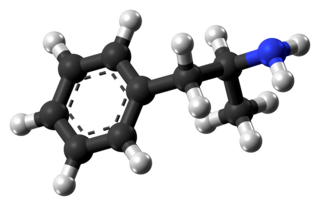Related Research Articles

Amphetamine is a central nervous system (CNS) stimulant that is used in the treatment of attention deficit hyperactivity disorder (ADHD), narcolepsy, and obesity. Amphetamine was discovered in 1887 and exists as two enantiomers: levoamphetamine and dextroamphetamine. Amphetamine properly refers to a specific chemical, the racemic free base, which is equal parts of the two enantiomers, levoamphetamine and dextroamphetamine, in their pure amine forms. The term is frequently used informally to refer to any combination of the enantiomers, or to either of them alone. Historically, it has been used to treat nasal congestion and depression. Amphetamine is also used as an athletic performance enhancer and cognitive enhancer, and recreationally as an aphrodisiac and euphoriant. It is a prescription drug in many countries, and unauthorized possession and distribution of amphetamine are often tightly controlled due to the significant health risks associated with recreational use.

Recreational drug use is the use of a psychoactive drug to induce an altered state of consciousness either for pleasure or for some other casual purpose or pastime by modifying the perceptions, feelings, and emotions of the user. When a psychoactive drug enters the user's body, it induces an intoxicating effect. Generally, recreational drugs are divided into three categories: depressants ; stimulants ; and hallucinogens.

Stimulants is an overarching term that covers many drugs including those that increase activity of the central nervous system and the body, drugs that are pleasurable and invigorating, or drugs that have sympathomimetic effects. Stimulants are widely used throughout the world as prescription medicines as well as without a prescription as performance-enhancing or recreational drugs. The most frequently prescribed stimulants as of 2013 were lisdexamfetamine, methylphenidate, and amphetamine. It was estimated in 2015 that the percentage of the world population that had used cocaine during a year was 0.4%. For the category "Amphetamines and prescription stimulants" the value was 0.7%, and for Ecstasy 0.4%.

Club drugs, also called rave drugs, or party drugs are a loosely defined category of recreational drugs which are associated with discothèques in the 1970s and nightclubs, dance clubs, electronic dance music (EDM) parties, and raves in the 1980s to today. Unlike many other categories, such as opiates and benzodiazepines, which are established according to pharmaceutical or chemical properties, club drugs are a "category of convenience", in which drugs are included due to the locations they are consumed and/or where the user goes while under the influence of the drugs. Club drugs are generally used by teens and young adults. This group of drugs is also called "designer drugs", as most are synthesized in a chemical lab rather than being sourced from plants or opiates.

Methylphenidate, sold under the trade name Ritalin and Concerta among others, is a stimulant drug used to treat attention-deficit/hyperactivity disorder (ADHD) and narcolepsy. It is a first-line medication for ADHD. It may be taken by mouth or applied to the skin, and different formulations have varying durations of effect.

Dextroamphetamine (D-AMP) is a central nervous system (CNS) stimulant and an amphetamine enantiomer that is prescribed for the treatment of attention deficit hyperactivity disorder (ADHD) and narcolepsy. It is also used as an athletic performance and cognitive enhancer, and recreationally as an aphrodisiac and euphoriant. Dextroamphetamine was also used in the past by some countries' military forces to fight fatigue during extended combat operations.

Empathogens or entactogens are a class of psychoactive drugs that produce experiences of emotional communion, oneness, relatedness, emotional openness—that is, empathy or sympathy—as particularly observed and reported for experiences with 3,4-methylenedioxymethamphetamine (MDMA). This class of drug is distinguished from the classes of hallucinogen or psychedelic, and amphetamine or stimulant. Major members of this class include MDMA, MDA, MDEA, MDOH, MBDB, 6-APB, methylone, mephedrone, αMT, and αET, MDAI among others. Most entactogens are phenethylamines and amphetamines, although several, such as αMT and αET, are tryptamines. When referring to MDMA and its counterparts, the term MDxx is often used. Entactogens are sometimes incorrectly referred to as hallucinogens or stimulants, although many entactogens such as ecstasy exhibit psychedelic or stimulant properties as well.
Stimulant psychosis is a mental disorder characterized by psychotic symptoms which involves and typically occurs following an overdose on psychostimulants; however, it has also been reported to occur in approximately 0.1% of individuals, or 1 out of every 1,000 people, within the first several weeks after starting amphetamine or methylphenidate therapy. Methamphetamine psychosis, or long-term effects of stimulant use in the brain, depend upon genetics and may persist for some time.

Adderall and Mydayis are trade names for a combination drug containing four salts of amphetamine. The mixture is composed of equal parts racemic amphetamine and dextroamphetamine, which produces a (3:1) ratio between dextroamphetamine and levoamphetamine, the two enantiomers of amphetamine. Both enantiomers are stimulants, but differ enough to give Adderall an effects profile distinct from those of racemic amphetamine or dextroamphetamine, which are marketed as Evekeo and Dexedrine/Zenzedi, respectively. Adderall is used in the treatment of attention deficit hyperactivity disorder (ADHD) and narcolepsy. It is also used as an athletic performance enhancer, cognitive enhancer, appetite suppressant, and recreationally as an aphrodisiac and euphoriant. It is a central nervous system (CNS) stimulant of the phenethylamine class.

Speedball refers to a mixture of cocaine with heroin or morphine taken intravenously or by nasal insufflation. Original speedball combinations used cocaine hydrochloride mixed with morphine sulfate, while modern speedballs may also use pharmaceutical opioids, benzodiazepines, or barbiturates along with stimulants.

Dexmethylphenidate, sold under the brand name Focalin among others, is a medication used to treat attention deficit hyperactivity disorder (ADHD) in those over the age of five years. If no benefit is seen after four weeks it is reasonable to discontinue its use. It is taken by mouth. The immediate release formulation lasts up to five hours while the extended release formulation lasts up to twelve hours.
Drugs and prostitution have been documented to have a direct correlation.
Lacing is the act of adding one or more substances to another. Some street drugs are commonly laced with other chemicals for various reasons, but it is most commonly done so as to bulk up the original product or to sell other, cheaper drugs in the place of something more expensive. Individuals sometimes lace their own drugs with another substance to combine or alter the physiological or psychoactive effects.
Coca paste is a crude extract of the coca leaf which contains 40% to 91% cocaine sulfate along with companion coca alkaloids and varying quantities of benzoic acid, methanol, and kerosene. In South America, coca paste, also known as cocaine base and, therefore, often confused with cocaine freebase in North America, is relatively inexpensive and is widely used by low-income populations. The coca paste is smoked in tobacco or cannabis cigarettes and use has become widespread in several Latin American countries. Traditionally, coca paste has been relatively abundant in South American countries such as Colombia where it is processed into cocaine hydrochloride for distribution to the rest of the world. The caustic reactions associated with the local application of coca paste prevents its use by oral, intranasal, mucosal, intramuscular, intravenous or subcutaneous routes. Coca paste can only be smoked when combined with a combustible material such as tobacco or cannabis.

Levamisole, sold under the brand name Ergamisol among others, is a medication used to treat parasitic worm infections. Specifically it is used for ascariasis and hookworm infections. It is taken by mouth.

Troparil is a stimulant drug used in scientific research. Troparil is a phenyltropane-based dopamine reuptake inhibitor (DRI) that is derived from methylecgonidine. Troparil is a few times more potent than cocaine as a dopamine reuptake inhibitor, but is less potent as a serotonin reuptake inhibitor, and has a duration spanning a few times longer, since the phenyl ring is directly connected to the tropane ring through a non-hydrolyzable carbon-carbon bond. The lack of an ester linkage removes the local anesthetic action from the drug, so troparil is a pure stimulant. This change in activity also makes troparil slightly less cardiotoxic than cocaine. The most commonly used form of troparil is the tartrate salt, but the hydrochloride and naphthalenedisulfonate salts are also available, as well as the free base.
Cocaine dependence is a biopsychosocial disorder characterized by persistent use of cocaine despite substantial harm and adverse consequences. The Diagnostic and Statistical Manual of Mental Disorders, classifies problematic cocaine use as a "Stimulant use disorder". The International Classification of Diseases, includes "Cocaine dependence" as a classification (diagnosis) under "Disorders due to use of cocaine".

RTI-126 is a phenyltropane derivative which acts as a potent monoamine reuptake inhibitor and stimulant drug, and has been sold as a designer drug. It is around 5 times more potent than cocaine at inhibiting monoamine reuptake in vitro, but is relatively unselective. It binds to all three monoamine transporters, although still with some selectivity for the dopamine transporter. RTI-126 has a fast onset of effects and short duration of action, and its pharmacological profile in animals is among the closest to cocaine itself out of all the drugs in the RTI series. Its main application in scientific research has been in studies investigating the influence of pharmacokinetics on the abuse potential of stimulant drugs, with its rapid entry into the brain thought to be a key factor in producing its high propensity for development of dependence in animals.

RTI(-4229)-112 is a synthetic stimulant drug from the phenyltropane family. In contrast to RTI-113, which is DAT selective, RTI-112 is a nonselective triple reuptake inhibitor.
Methadone maintenance treatment is the use of methadone, administered over a prolonged period of time, as treatment for someone who is addicted to opioids such as heroin, where detoxification has been unsuccessful and/or admittance to a substance abuse treatment facility requires complete abstinence. "Methadone maintenance makes possible a first step toward social rehabilitation" because it allows addicts to avoid the uncomfortable withdrawal symptoms that result from complete abstinence. Methadone maintenance can also be used for patients who suffer with severe pain problems that are resistant to other drugs.
References
- ↑ Stimulant Therapy. "Stimulant Therapy for Cocaine addiction" . Retrieved 3 January 2014.CS1 maint: discouraged parameter (link)
- ↑ Stimulant Maintenance. "Drug Therapy in Vancouver". Archived from the original on 16 April 2014. Retrieved 3 January 2014.CS1 maint: discouraged parameter (link)